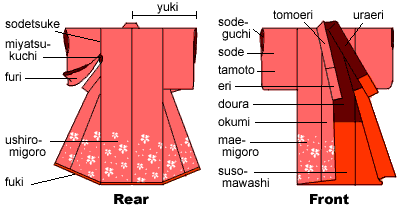AnnaMayBelle (talk | contribs) No edit summary |
AnnaMayBelle (talk | contribs) No edit summary |
||
| Line 21: | Line 21: | ||
===Mae-Migoro - 前身頃=== |
===Mae-Migoro - 前身頃=== |
||
| + | The wide panel of the body of the kimono, extending from the front of the body, over the shoulder, and down the back, without a seam at the shoulder. If there is a seam, it will be across the middle of the back, where it would not be seen when the obi is worn. |
||
| + | |||
| + | |||
| + | ===Miyatsukuchi (not illustrated)=== |
||
Revision as of 02:00, 30 October 2012

A diagram of kimono by Japan-Zone.com (http://www.japan-zone.com/culture/kimono.shtml)
The many parts of kimono each have their own individual names. While it is not necessary to know every term in order to wear and enjoy kimono, learning them can be very useful when shopping for kimono or describing one.
The kimono is a symetrical garment, unlike some western clothes, and the same terms apply to both the left and right sides of the kimono. The same terms still apply to informal yukata, except that yukata and some kimono lack doura and susomawashi (parts of the lining, as described below).
Doura - 胴裏
This is the upper lining of the inside of the kimono. In women's kimono, this lining is often made of very simple fabric because it will not be seen when the kimono is worn.
Eri - 衿
This is the collar of the kimono. Because it is made of a 1/4 width of the bolt, it is the same width as the okumi (see below), but is folded in half when the kimono is donned in order to provide extra stiffness. Some modern kimono have snaps in the back of the eri to help hold it folded in half, while yukata or thin kimono such as ro or sha weaves may have the collars sewn into the folded position. It is not uncommon to find old and vintage kimono with worn lines along the crease of the eri.
Fuki
The "hem guard" at the bottom of the kimono.
Furi
The portion of the sleeve below the arm hole, IE, the part of the sleeve that 'swings'.
Mae-Migoro - 前身頃
The wide panel of the body of the kimono, extending from the front of the body, over the shoulder, and down the back, without a seam at the shoulder. If there is a seam, it will be across the middle of the back, where it would not be seen when the obi is worn.